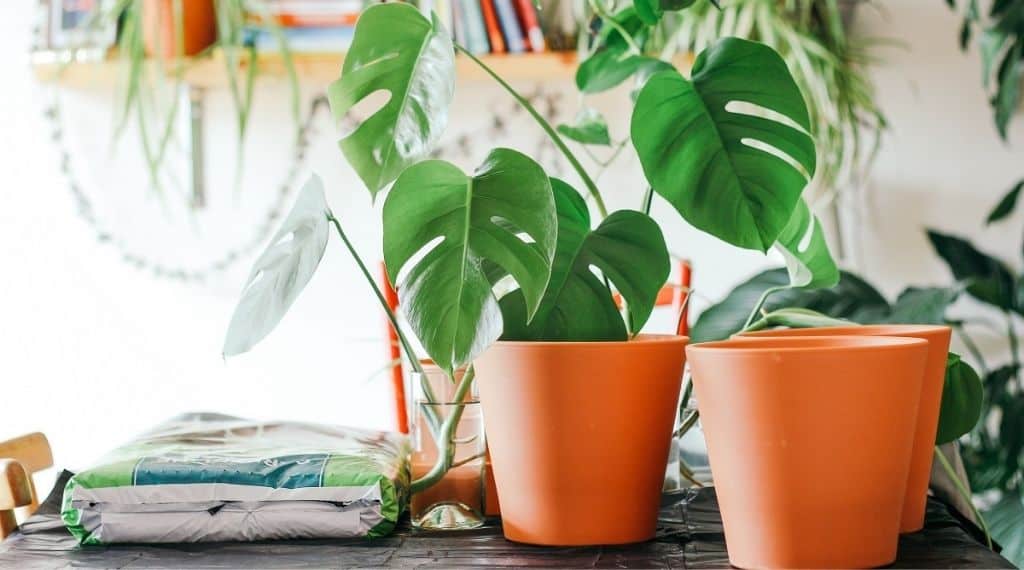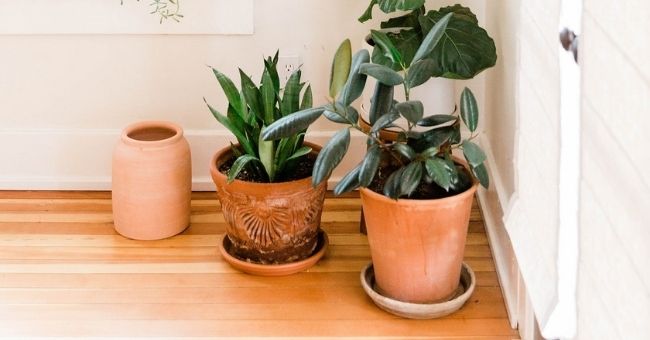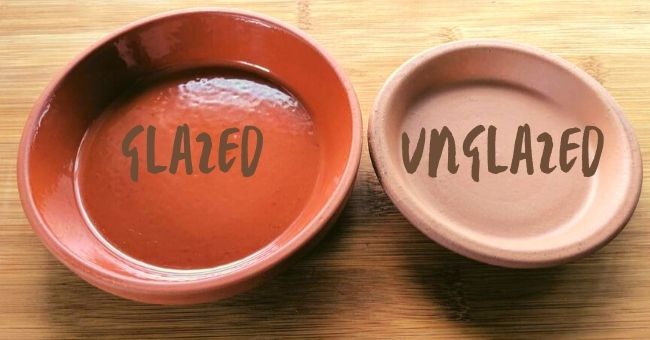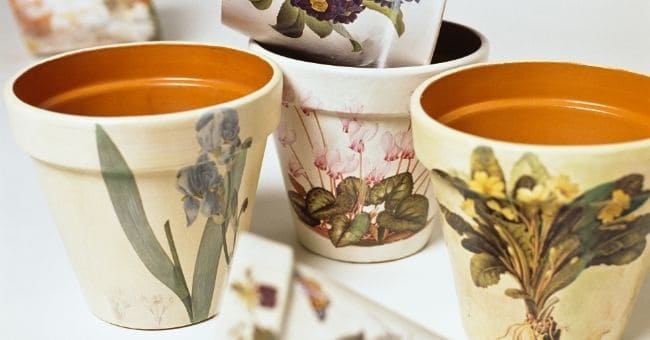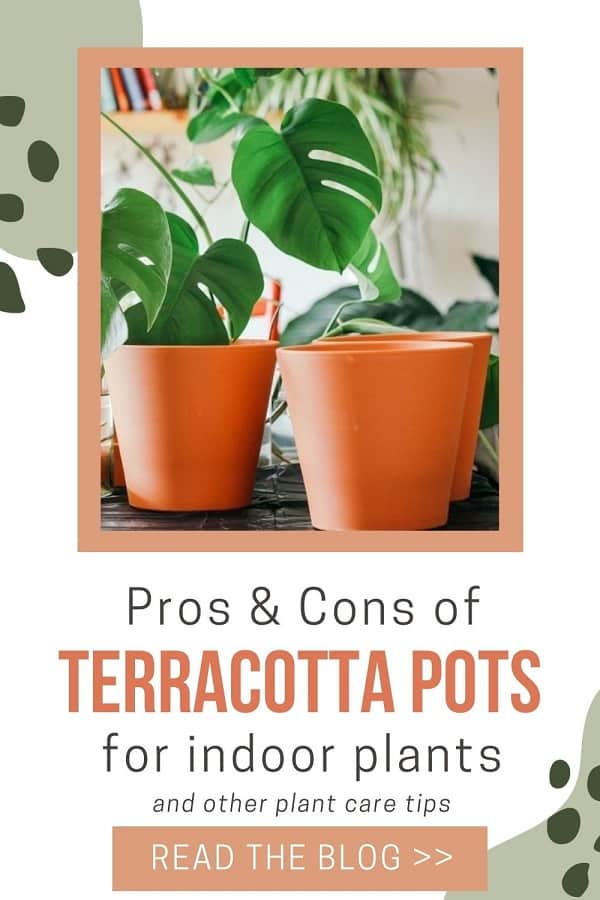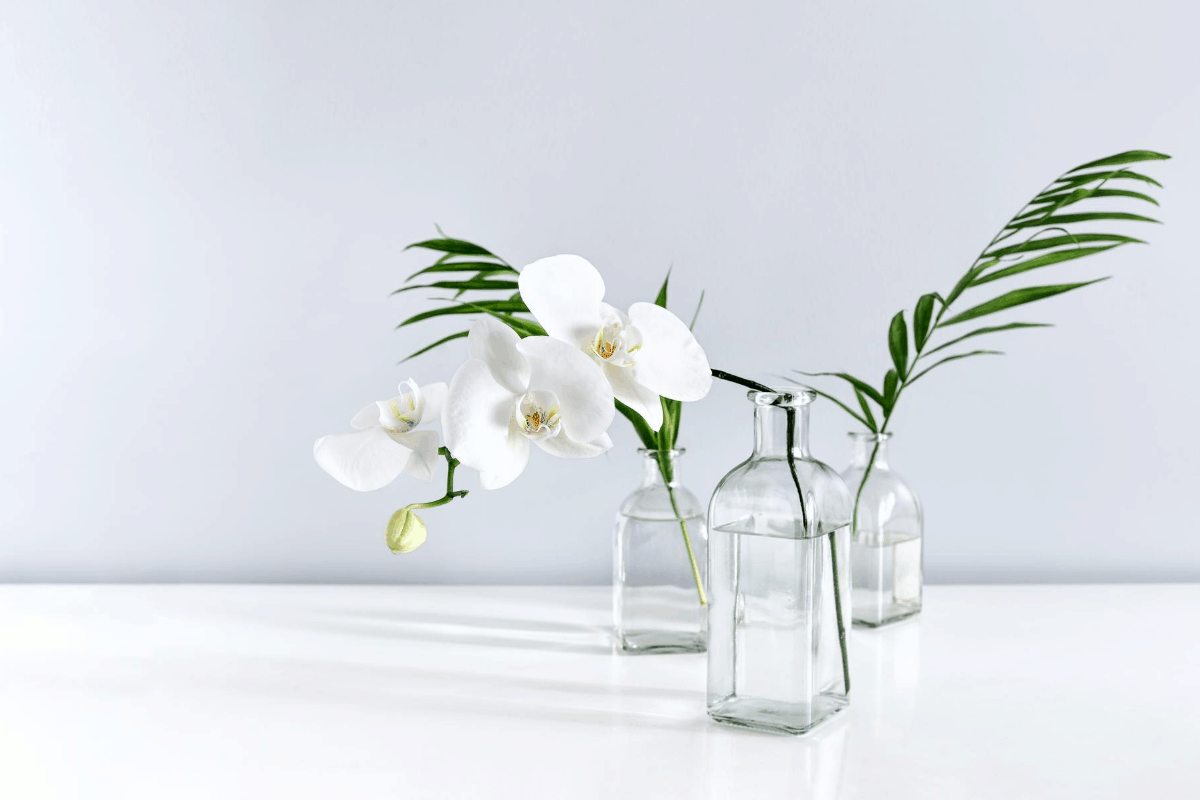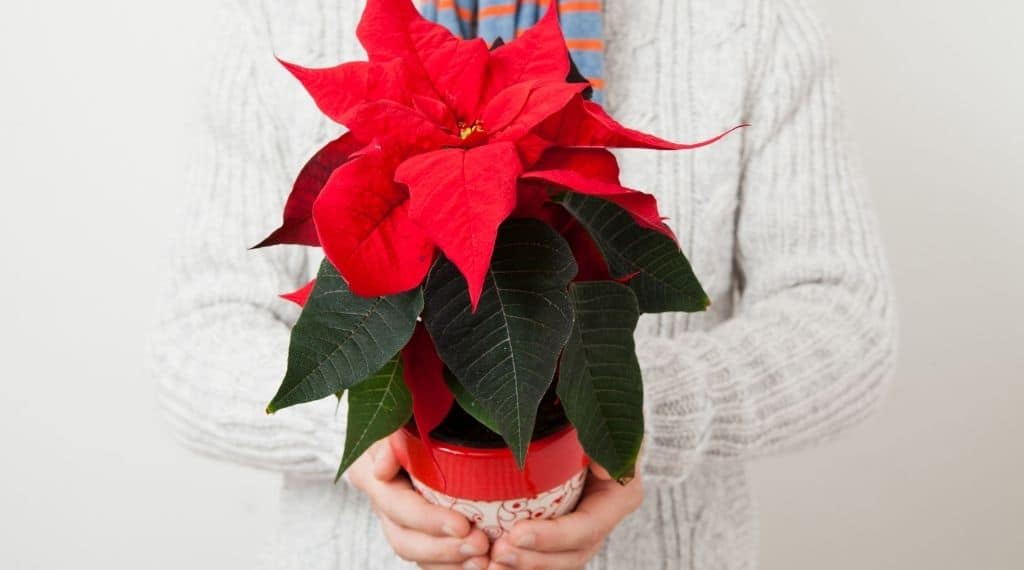Last Updated on October 5, 2021 by Plantiful Interiors
Terracotta Pots For Indoor Plants
There are many different types of pots available to choose from when it comes to indoor plants. Choosing the right type of pot comes down to more than just what looks pretty (though that definitely plays a factor).
You should also consider the material of the pot and the growing conditions your plant needs.
Terracotta pots are one of the most common types of pot you’ll see at your local greenhouse. These types of pots have been around for centuries.
But, are terracotta pots good for houseplants?
The answer is yes, terracotta pots are good for houseplants – but this can depend on your plants and plant care routine.
Sound confusing? Don’t worry.
This article will clear everything up. We’ll cover:
- pros and cons of using terracotta pots for houseplants
- which plants like terracotta pots
- how to use terracotta-based pots
- and maintenance tips to keep your pots longer
Next time you’re looking for the perfect pot for your new plant, you’ll know if terracotta is the way to go, or if you should choose a different type.
This site features affiliate content. As an affiliate partner of various brands, we earn commissions on qualifying purchases, at no extra cost to you. Please read our disclaimer for more information.
Benefits Of Using Terracotta Pots For Houseplants
Let’s dive into the benefits of terracotta pots.
Terracotta pots are especially breathable and porous
Terracotta pots are made from fired clay, giving them their Italian namesake, meaning “baked earth”.
Terracotta pots absorb water and allow water to escape through their sides and evaporate easily. In addition, air and oxygen can pass in and out of terracotta pots easily.
All of this combined helps prevent plants from being overwatered which often leads to root rot and death.
Terracotta pots work with houseplants that like relatively dry soil
Because of their ability to absorb water along with their drain holes, houseplants that like dry conditions do especially well in terracotta pots.
Some of the plants that grow best in terracotta plants include:
- Peperomia (Radiator Plants)
- Pilea (Chinese money plants)
- Hoya (Wax Plants)
- Sansevieria (Snake Plants)
- Epiphyllum (Climbing Cacti)
- Moth Orchids
- Succulents
- Cacti
- Basil
TIP: To prevent soil from spilling out of the drain holes in the bottom of the pot, place a coffee filter inside your pot before adding soil. This will allow the water to continue to drain but keep the soil inside.
Terracotta pots are sturdier than other pots
Although terracotta pots are breakable they are much sturdier than plastic pots.
The weight of the pots when filled makes them excellent for top-heavy plants. They are also harder for your pets to knock over.
And, if your indoor plant needs to be moved from time to time, terracotta pots are comparatively (versus concrete pots) lightweight.
Terracotta pots develop efflorescence (white crusty residue)
If you’re wondering what that white crusty look on your terracotta pot is, don’t worry, it’s completely normal and healthy.
The whitish crusting of minerals on your terracotta pot’s exterior is called efflorescence. It’s caused by leeching calcium (or lime) and mineral deposits from hard tap waters and fertilizers.
Once considered unsightly, efflorescence is now favored by some who like the worn, earthy appearance of these minerals on a simple, rust-colored pot. However, if you don’t like the look keep reading for some tips on how to clean your terracotta pot.
Disadvantages Of Using Terracotta Pots for Houseplants
Let’s take a look at a few reasons why you may not want to consider using terracotta pots for your plants.
Terracotta pots are relatively high-maintenance
Because terracotta is so porous, it can contain mineral deposits, plant bacteria, and viruses over time. To keep your terracotta pots sanitary and usable, you will have to soak, wash, clean, disinfect, and/or waterproof them. We go into more detailed cleaning instructions later in this article.
Terracotta pots may not be suitable for all plant types
Some houseplants require pots that do not leech water as easily as terracotta pots.
Plants that won’t do well in terracotta pots are:
- Soleirolia (Baby’s Tears)
- Epipremnum (Golden Pothos)
- Chlorophytum (Spider Plants)
- Ferns
Before deciding which type of pot you should plant in, check out their care instructions. If the plant requires soil that stays moist, you’re better off avoiding terracotta and choosing a plastic or ceramic pot instead.
Terracotta pots are only sturdy up to a point
As we mentioned earlier, terracotta pots are fairly sturdy, but they aren’t exactly unbreakable.
If you have pets or small children indoors, a concrete pot may be a more suitable choice.
Terracotta pots are also known to crack and chip when exposed to cold weather. Keep them away from drafty windows and don’t store them outside in the winter.
Now that you know the pros and cons of using terracotta pots for your indoor plants, and have an understanding of which plants like terracotta pots, let’s look at the difference between clay pots and terracotta pots, and how to use terracotta pots.
What Is The Difference Between Clay Pots And Terracotta Pots?
Clay pots are created by using the natural clay found in the earth’s soil. The clay is left to harden in the shape desired and painted with an impenetrable gloss to keep the pot the same consistency. However, this gloss can be dangerous for many house plants as the moisture is sealed in and does not allow the soil and plant to breathe, but it does lengthen these pots’ durability, helping them last much longer than terracotta pots.
On the other hand, terracotta pots are also made out of clay but baked at a high enough heat to no longer have a soft consistency, even when moistened. Once created, the terracotta pots may be coated in a glossy finish or left in it’s natural state. If a gloss is applied, it will be one that allows for plant respiration. This type of coating is a water-based one and is perfectly safe for plants.
Terracotta pots are easy to identify as they are always an orange-red color similar to rust (dark or bright) but a clay pot can range in any color.
TIP: Clay pots and ceramic pots are typically coated to give them a shiny look,
however, terracotta is generally left in its naturally matte form.
How To Prepare Your Terracotta Pot For Planting
To prepare your terracotta pot for indoor use, make sure it is clean, disinfected, and otherwise free of residual dirt or bacteria (explained in the next section).
Step 1: If you are using a new pot, let it soak in warm water for at least half an hour. This will ensure the pot does not dry your plant’s soil prematurely.
Step 2: Put a glazed terracotta or plastic saucer under your terracotta pot to catch any excess water and prevent water damage to your furniture or floor.
Step 3: Place your pot in the saucer. Add new potting mix to the bottom of the pot and pat it down. Place your plant (roots and all) inside the pot and pour/place new potting mix around the roots in a somewhat looser fashion. Once your plant can stand well enough on its own, it has been potted successfully. Water as necessary.
Step 4: Water as necessary.
TIP: If you choose to place a terracotta saucer under your pot, make sure it is glazed. A glazed saucer will prevent the water from being absorbed by the terracotta material which could lead to water damage on your furniture.
How To Clean Terracotta Pots
To remove mineral deposits and dirt from old terracotta pots, you will have to clean them.
There are two different ways you can clean terracotta pots. One is to use vinegar, the other uses bleach.
How To Clean Terracotta Pots with Vinegar
Step 1: Use a bristled flower pot brush to clean loose soil from the pot’s interior.
Step 2: Soak the pot in vinegar (white vinegar or cleaning vinegar) and warm water. You’ll want to use a solution that is three parts water and one part vinegar, and let soak for half an hour (some sources say up to 24 hours, if necessary).
Step 3: Soak the pot in pure warm water for another half hour, or rinse with warm water to remove any vinegar residue.
Step 4: Let the pot dry completely before planting.
How To Clean Terracotta Pots With Bleach
Separate from cleaning your pots is the bleaching process. This process is to truly disinfect the terracotta pot from bacteria and plant diseases.
Always use gloves when handling bleach and bleach solutions – and be careful.
Step 1: Make a solution that is four parts water and one part bleach.
Step 2: Place the pot in the solution and let it soak for four hours.
Step 3: Using gloves, retrieve the pot from the solution, and let soak in clean, warm water for another hour.
Step 4: Rinse the pot clean to remove any leftover bleach.
Step 5: Allow the pot to dry completely before using.
Tips For Using Terracotta Pots Indoors
How To Tell If Your Terracotta Pot Is Waterproof
As you learned earlier in the article, one of the main benefits of terracotta pots is their porous material. Their ability to absorb water makes it less likely to overwater your plants.
Because of this, terracotta pots normally are not waterproof – and they will usually have a dull, rust-colored appearance.
If your terracotta pot has been waterproofed, it will have a shiny, glazed ceramic appearance.
You might be wondering, why would I want to waterproof my terracotta pot?
By waterproofing, or sealing, your terracotta pot, your pot will retain more water. It is highly advised that you read the care instructions for your plant before deciding if you want to waterproof your terracotta pots.
If you plan on using your pots for the plants mentioned above that like dry conditions, it is not advised to waterproof your pot. But, if your plant requires moist and wet conditions then waterproofing your pot will allow you to water less frequently.
How To Waterproof Your Terracotta Pot
First, wash your terracotta pot with a drop of dish detergent and warm water. Scrub the interior with a flower pot brush, and use a paper towel and vinegar to remove outer mineral deposits.
Rinse and dry with a paper towel (let it dry completely).
Then, use a paintbrush to put terracotta sealant (or exterior varnish) on the interior of the pot. Allow this layer to dry completely, then brush the interior again with the sealant, and let dry.
Do the same two-coat treatment for the pot’s exterior. Let dry completely.
Garden Answer has tested various sealers. Watch the video below to find out what the best sealer for terracotta pots is.
How To Paint A Terracotta Pot
We’ll admit, terracotta pots aren’t the most aesthetically appealing. If you want your terracotta pots to match your interior decor, or at least look a little less dull, you can paint them.
Yes, it’s completely OK to paint your terracotta pot. Adding paint to your terracotta pot will reduce the amount of your pot is able to breathe but not enough to make it unusable.
To paint a terracotta pot, use acrylic craft paints for the best results.
Soak your pot in warm water for up to an hour, and then brush it clean if necessary.
Painting Your Pot
First, thin some acrylic paint with water on a plastic plate.
Use a foam brush to paint an even base coat on the pot’s exterior.
Do the same with the inner upper lip. Leave the rest of the interior unpainted. If you need to, put on another base coat (once the first application has dried completely).
Using different-colored paint and cotton swabs (or an artist’s brush) paint on finer details.
Allow the pot to dry completely (this may take a few days). Then apply waterproofing to the exterior and painted interior areas and let dry.
Need some inspiration? Check out Make It & Love It for 25 design ideas to paint terracotta pots.
Frequently Asked Questions About Terracotta Pots
What size of terracotta pot should I use for my houseplant?
If you are simply transplanting a new plant you just purchased from the grower’s pot it came into a more aesthetically pleasing pot, use the same size pot. However, if you are re-potting because your plant has outgrown its current pot, choose a pot that is 2-4 inches in diameter larger than the existing pot. It is essential to remember plants need to root into the soil and develop in a circular motion around the base root of the plant. On average, you should allow for a couple of inches of room around the edges of the pot for the roots to grow. Where the roots won’t reach in the pot (vertically or horizontally), the left-over soil will allow for excess water drainage which is crucial for plant survival.
How long do terracotta pots last?
On average, most terracotta pots last approx. 3 to 4 years. However, some people may use water-based sealers which allow for penetration of moisture and air, but also keep the terracotta pot in a pristine condition that can last up to 8 years if maintained.
Why does my terracotta pot have white residue on it?
Terracotta pots are made out of clay, which is essentially a porous material. The pores allow the interior of the soil and plant to breathe, which then secrete the minerals and natural salts of the water used to hydrate the plants. The white residue on your terracotta pot is the hardened salts and minerals. The residue is not harmful and can be simply removed with a cloth and some water.
More Plant Care Articles:
Must Have Indoor Plant Care Tools To Keep Plants Alive
Best Greenhouses for Indoor Plants
50 + Cute & Funny Plant Sayings for Your Next DIY Plant Pot Project

